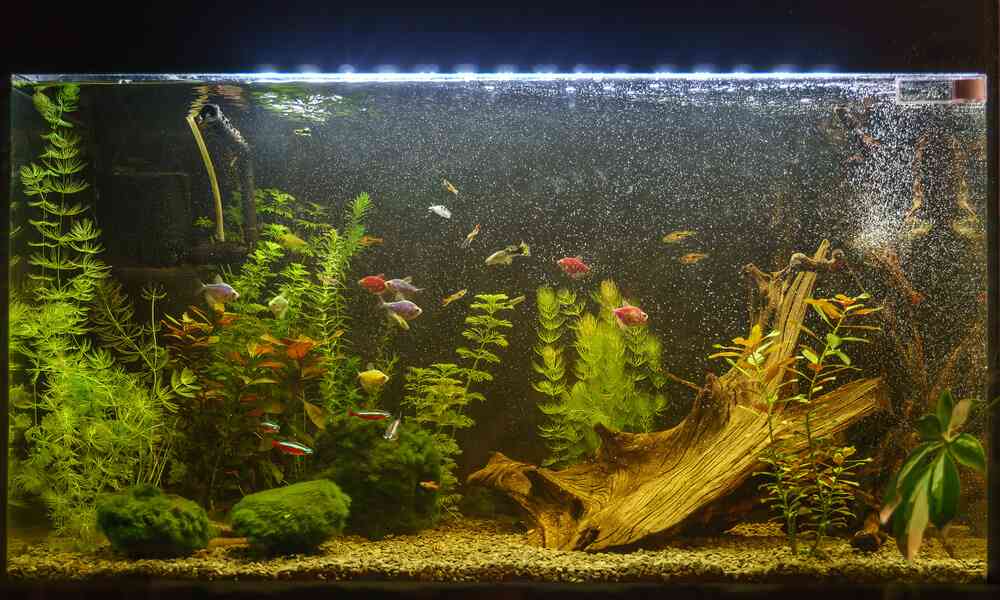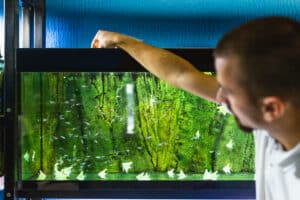Aquarium pumps are wonderful things since they help in aerating the fish tank. But sometimes, they can be noisy. And unless you have battery powered pumps, they can go out during a power outage and put you in a panic.
Not only that, you may also prefer to create environments without them, for the aesthetics and to get things a little closer to what Nature intended.
So in this post, we’re going to help with these types of scenarios by providing you with 7 smart ways to aerate a fish tank without a pump. It’s actually not as hard as you might think – it’s really just a matter of knowing your options!
Clever additions to your tank, such as Lily Pipes, filters that create waterfall effect, and others can make a world of difference – read on and we’ll share these aeration tips with you so that you can incorporate them into your own aquatic wonderlands!
#1. Creating Waterfall effect using filter
Filters that create waterfall effects are an aesthetically-pleasing option that can get the job done with style!
| Filters That Don’t Need Air Pump: | Filters That Need Air Pump: |
| Hang-On-Back Filter | Sponge Filter |
| Canister Filter | Undergravel Filter |
Perfect for all types of tanks – long or narrow, as well as micro or cubic-style tanks, the important thing with filters is to focus on agitation.
Strong surface agitation due the fast-falling water causes tank water to get more air exposure, which in turn raises the oxygen levels in the water. This means that you’ll want to make sure that you mount the filter in such a way that they aren’t trickling, but rather high enough to give a good, agitating splash.
They look absolutely amazing, just make sure that you are cleaning your filters every few weeks to maintain them and to ensure top performance from your investment.
#2. Using Wavemaker to create surface water movement
Just like its name – a wavemaker is a simple aquarium equipment used by aquarists to maintain adequate water circulation in the tank.
It doesn’t require support of any other aquarium equipment like a pump. You simply plug its electric outlet, attach the wavemaker on one of the tank walls (with suction cups that usually comes along with it) and it starts to function.
It works like an underwater fan generating nice water current – entertaining your fish species and at the same time ensuring that there are no more dead spots in the tank where dust can get collected.
The wavemaker helps in removing the dust and fish waste that usually gets accumulated in specific spots in the fish tank.
The water currents generated by the wavemaker causes the debris to gradually move towards the inlet of the fish tank filter – and from there it easily gets sucked in by the filter. Thus, wavemakers allow the fish tank water to remain crystal clean.
Now here’s the thing:
When you set up the aquarium wavemaker pointing at the top of the surface, it helps in creating surface water movement – and naturally helps in aerating the tank.
Since there are so many benefits of having a wavemaker, we highly recommend getting one, especially if you have a large tank and are struggling to keep your tank clean.
#3. Nature can definitely lend you a helping hand

Whenever you have a biological solution, it’s good to take advantage of it. Nature has provided one of the most beautiful and effective options in the form of aquarium plants.
By placing plants in your tank, you not only up the overall aesthetics, but the plants will give you a helping hand by producing oxygen and reducing carbon dioxide and ammonia levels for your fish. Note that this will only occur during the day, as the lighting will help in photosynthesis during this time.
This means that during the day they’ll absorb carbon dioxide and produce oxygen, although at night it will be the reverse. Don’t worry – this will only rarely result in dangerously-low levels of oxygen at night, although you can help to balance things with a waterfall or another of our aeration solutions if you like.
NOTE: Although aquarium plants help in oxygenating and aerating the tank, we still highly recommend having at least one aquarium equipment (like a filter) to create adequate surface water movement and oxygenate the tank.
#4. A wider, shallower tank can hold more oxygen
The design of the tank has an impact on how much oxygen it’s going to be able to easily hold. You can take advantage of this by going with a wider, shallower tank. This is because of the larger surface area.
As a general rule, the larger the surface area, the more oxygen can potentially be dissolved within your tank.
As a backup to ensure proper oxygenation levels, add aquarium plants to your tank and more importantly, a filter. This way, you’ll be able to forego the pump but you should still be able to achieve a high level of oxygenation for the happy, swimming friends you are hosting in your carefully-prepared tank.
Recommended Read: How Long Can Fish Live Without Oxygen?
#5. Lily pipes work wonderfully for aeration
Plastic tubing is ugly and can really detract from your carefully cultivated tank and the environment within, so why not try Lily pipes? Crystalline Lily pipes are a type of glassware that look quite nice or if you prefer the modern grace of stainless steel then you can get your Lily Pipes in this form.
The way that they work is that you attach them to the filter at the outlet port, so that they curve down gracefully into the water in such a position as to break the surface tension.
As with a waterfall, this added agitation provides mild aeration, along with enhanced oxygen assimilation as the Lily Pumps do their work.
There are outflow and inflow Lilly Pipe configurations, with the outflow setup providing enhanced water flow, while the inflow setup is just a way of getting your filtration without those unattractive plastic intakes.
However, you decide to use them, they can definitely make a solid impact on oxygen levels while upgrading your tank’s good looks!
#6. Changing out the water is sometimes the best solution
If carbon dioxide levels have reached an alarming level of saturation, then the best solution is often a water change – or rather, 1 quarter to half of one!
With larger tanks, you want to be especially careful about removing half of the water in one go, so we recommend that you remove 25 or even 20 percent, replacing it with freshwater that has been dechlorinated.
Once this is done, check the CO2 levels in the tank to see if you have effected enough of a change, but if needed you can change up to 50% of the tank water. We recommend for best oxygenation that while you do this, pour the water back in from a sufficient height so that you get a bit of agitation.
This will serve to better oxygenate the new water to get it back to the proper, healthy levels that you need. After that, consider some of the tips that we have listed previously in this article to see how you can help to prevent this from occurring again.
If you are consistently getting high CO2 levels then this is not something that you’ll want to ignore, as all it takes is one emergency where you have to work late or be away from home for a space for a CO2 problem to end in tragedy.
#7. Got a pitcher? Then you’ve got an Oxygenation hack!
If your tank is a little high on CO2, but not enough to warrant out changing large amounts of water, then there’s a simple hack that you can use to quickly make a difference. All you are going to need is a pitcher and a bit of patience. Here’s what you need to do:
- Taking your pitcher, carefully dip it into the water to fill it as much as you can without accidentally scooping up any fish
- Pour this water back into your tank, being careful not to disturb any substrate that might be adversely affected by the motion of the water re-entering the tank.
- If you have a lot of accessories or sensitive substrate, then don’t worry – take a saucer, bowl, or a plate from the kitchen that you don’t like and pour the water on this instead. That way, the splash will have less impact, but the water will still get oxygenated through splashing on your ‘impact buffer’ plate, bowl, or saucer.
- Repeat the process until the oxygen levels are satisfactory and while you’re at it, check the ammonia levels for good measure.
Wrapping Up
So there you have it – the 7 smart ways to aerate a fish tank without a pump and as you can see, you’re definitely not short on options.
A simple pitcher can oxygenate the tank in a pinch, while longer-range strategies like using plants, and waterfall-effect using filters can enhance the looks and livability of your tank quite gracefully.
In short, with careful planning of your aquatic environment and these tips, you should be able to get rid of those noisy pumps and craft together something a little more like Nature intended.
Hi! I’m Praveen Ghoshal, the founder of eFishkeeping.com. Inspired by my Dad, I got interested in fishkeeping when I was a kid. Since then, I have been involved with this hobby. Currently, I have 3 fish tanks at our home, and I enjoy this hobby with my full family. Read more about me here.







